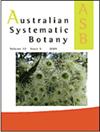Chloantheae一新属一新种(Lamiaceae)
IF 1.5
3区 生物学
Q4 EVOLUTIONARY BIOLOGY
引用次数: 1
摘要
摘要基于三标记叶绿体和核DNA数据集对Chloantheae(Lamiaceae)的分子系统发育进行了测试。,Newcastelia F.Muell.和Physopsis Turcz。从“核心”Lachnostachys、Newcastelia和Physopsis分支中分别发现了一个由每个属至少一个物种组成的分支。该复合支的成员在这里被转移到新属Apatelandha T.C.Wilson和M.J.Henwood,其可以通过花柱基部无毛或仅具有非腺毛(缺少腺毛)的组合来识别,花冠裂片的先端(当存在时)锐尖到钝(不延伸成顶端突起)和薄纹理(不明显加厚),信息素叶对生三朵花,花药连接部无毛(无柄腺体)。本文对Apatelandha的新属、五种新组合进行了描述,并对Lachnostachys、Newcastelia和Physopsis进行了修改。描述并举例说明了一个新物种,即棒柄新卡斯特利亚T.C.Wilson&Radunz。提供了Chloantheae属的分类索引,以及Lachnostachys、Newcastelia、Physopsis和Apatelandha属的物种索引。本文章由计算机程序翻译,如有差异,请以英文原文为准。
A new genus and species for Chloantheae (Lamiaceae)
Abstract. A molecular phylogeny of Chloantheae (Lamiaceae) based on a three-marker chloroplast and nuclear DNA dataset was used to test the monophyly of Lachnostachys Hook., Newcastelia F.Muell. and Physopsis Turcz. A clade consisting of at least one species from each of these genera was recovered separately from the ‘core’ Lachnostachys, Newcastelia and Physopsis clades. The members of this composite clade are here transferred to the new genus, Apatelantha T.C.Wilson & M.J.Henwood, which can be recognised by a combination of the base of the style being glabrous or with only non-glandular trichomes (glandular trichomes lacking), apex of corolla lobes (when present) acute to obtuse (not extending into an apical protrusion) and thin-textured (not distinctively thickened), pherophylls subtending three flowers, and anther connectives glabrous (sessile glands absent). A description of the new genus, together with new combinations for five species of Apatelantha, and amended descriptions of Lachnostachys, Newcastelia and Physopsis, are provided. A new species, Newcastelia clavipetala T.C.Wilson & Radunz, is described and illustrated. A taxonomic key to genera of Chloantheae, and keys to species of Lachnostachys, Newcastelia, Physopsis and Apatelantha are provided.
求助全文
通过发布文献求助,成功后即可免费获取论文全文。
去求助
来源期刊

Australian Systematic Botany
生物-进化生物学
CiteScore
3.10
自引率
12.50%
发文量
12
审稿时长
>12 weeks
期刊介绍:
Australian Systematic Botany is an international journal devoted to the systematics, taxonomy, and related aspects of biogeography and evolution of all algae, fungi and plants, including fossils. Descriptive taxonomic papers should normally constitute a comprehensive treatment of a group. Short papers on individual species and nomenclatural papers must contain significant new information of broader interest to be considered. The prestigious L.A.S. Johnson Review Series is published. Other review articles will also be considered. All papers are peer reviewed.
Australian Systematic Botany is published with the endorsement of the Commonwealth Scientific and Industrial Research Organisation (CSIRO) and the Australian Academy of Science.
 求助内容:
求助内容: 应助结果提醒方式:
应助结果提醒方式:


